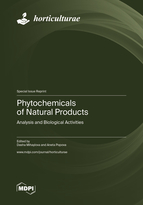Phytochemicals of Natural Products: Analysis and Biological Activities
A special issue of Horticulturae (ISSN 2311-7524). This special issue belongs to the section "Postharvest Biology, Quality, Safety, and Technology".
Deadline for manuscript submissions: closed (31 March 2022) | Viewed by 47708
Special Issue Editors
Interests: biological activity; antioxidants; analytical methods; phytochemistry; bioaccessibility; food chemistry; fruit quality
Special Issues, Collections and Topics in MDPI journals
Interests: dietary habits; healthy lifestyle; eating disorders; plant-based nutrition; phytochemistry; food chemistry; fruit characteristics
Special Issues, Collections and Topics in MDPI journals
Special Issue Information
Dear Colleagues,
The plant kingdom, with its natural products, both terrestrial and marine, has been widely explored. Plant-based products have been long used in the prevention and treatment of various ailments. Many natural compounds have been reported to have a variety of interesting and significant biological activities, such as antioxidant, anti-inflammatory, antitumor, antibacterial, antiviral, antifungal, antiparasitic, analgesic, antidiabetic, anti-atherogenic, antiproliferative, as well as cardio- and neuroprotective activities.
Therefore, researchers pay special attention to the bioactive compounds synthesized by plants. Opportunities in the fields of functional ingredients and treatment of NCDs (oxidative stress, diabetes, obesity, metabolic syndrome, etc.) are widely explored.
However, undeniably, many therapeutic properties of plants are still to be discovered. This Special Issue is intended to substantially contribute to our knowledge on their beneficial properties. Natural products could be a vast resource in respect of human wellbeing improvement.
This Special Issue aims at disseminating some of the most recent and significant contributions in natural products research on both phytochemicals and biological activities. In this regard, a contribution to our current Special Issue on “Phytochemicals of natural products: Analysis and biological activities” (original research paper, short communication, focus review) is highly encouraged.
Dr. Dasha Mihaylova
Dr. Aneta Popova
Guest Editors
Manuscript Submission Information
Manuscripts should be submitted online at www.mdpi.com by registering and logging in to this website. Once you are registered, click here to go to the submission form. Manuscripts can be submitted until the deadline. All submissions that pass pre-check are peer-reviewed. Accepted papers will be published continuously in the journal (as soon as accepted) and will be listed together on the special issue website. Research articles, review articles as well as short communications are invited. For planned papers, a title and short abstract (about 100 words) can be sent to the Editorial Office for announcement on this website.
Submitted manuscripts should not have been published previously, nor be under consideration for publication elsewhere (except conference proceedings papers). All manuscripts are thoroughly refereed through a single-blind peer-review process. A guide for authors and other relevant information for submission of manuscripts is available on the Instructions for Authors page. Horticulturae is an international peer-reviewed open access monthly journal published by MDPI.
Please visit the Instructions for Authors page before submitting a manuscript. The Article Processing Charge (APC) for publication in this open access journal is 2200 CHF (Swiss Francs). Submitted papers should be well formatted and use good English. Authors may use MDPI's English editing service prior to publication or during author revisions.
Keywords
- natural products
- polyphenols
- antioxidants
- analytical methods
- phytochemical compounds
- biological activity and effects
- nutrients
- functional foods







